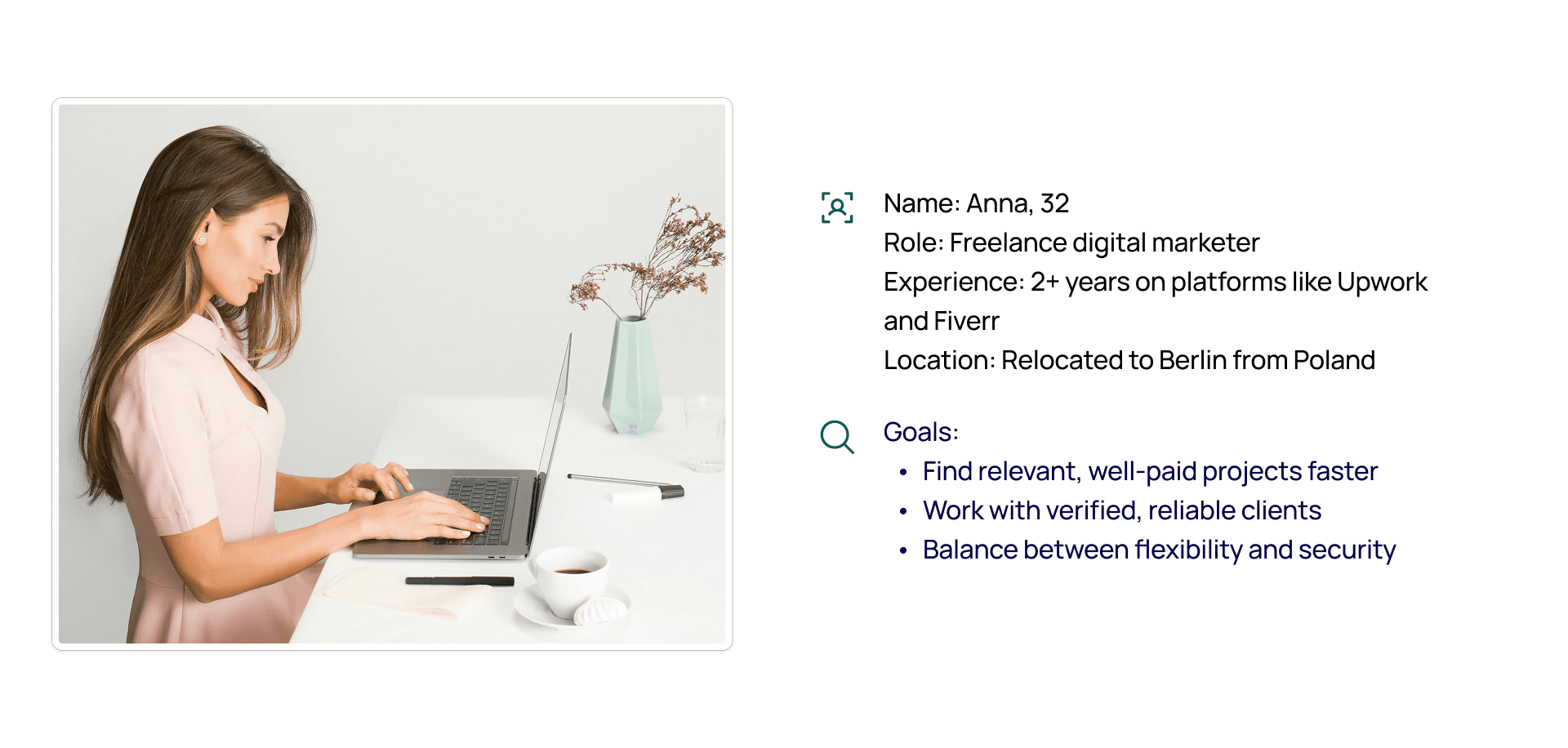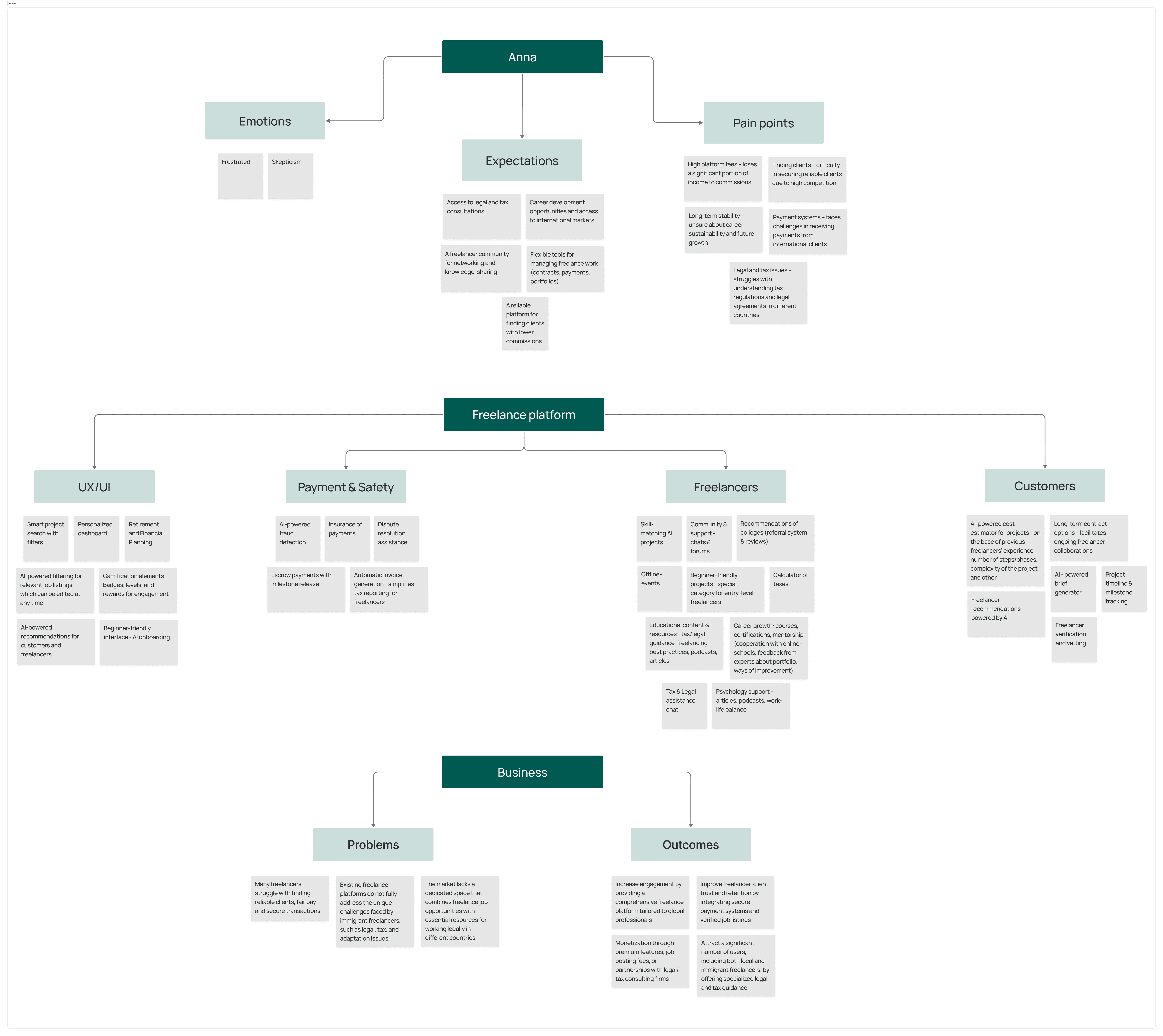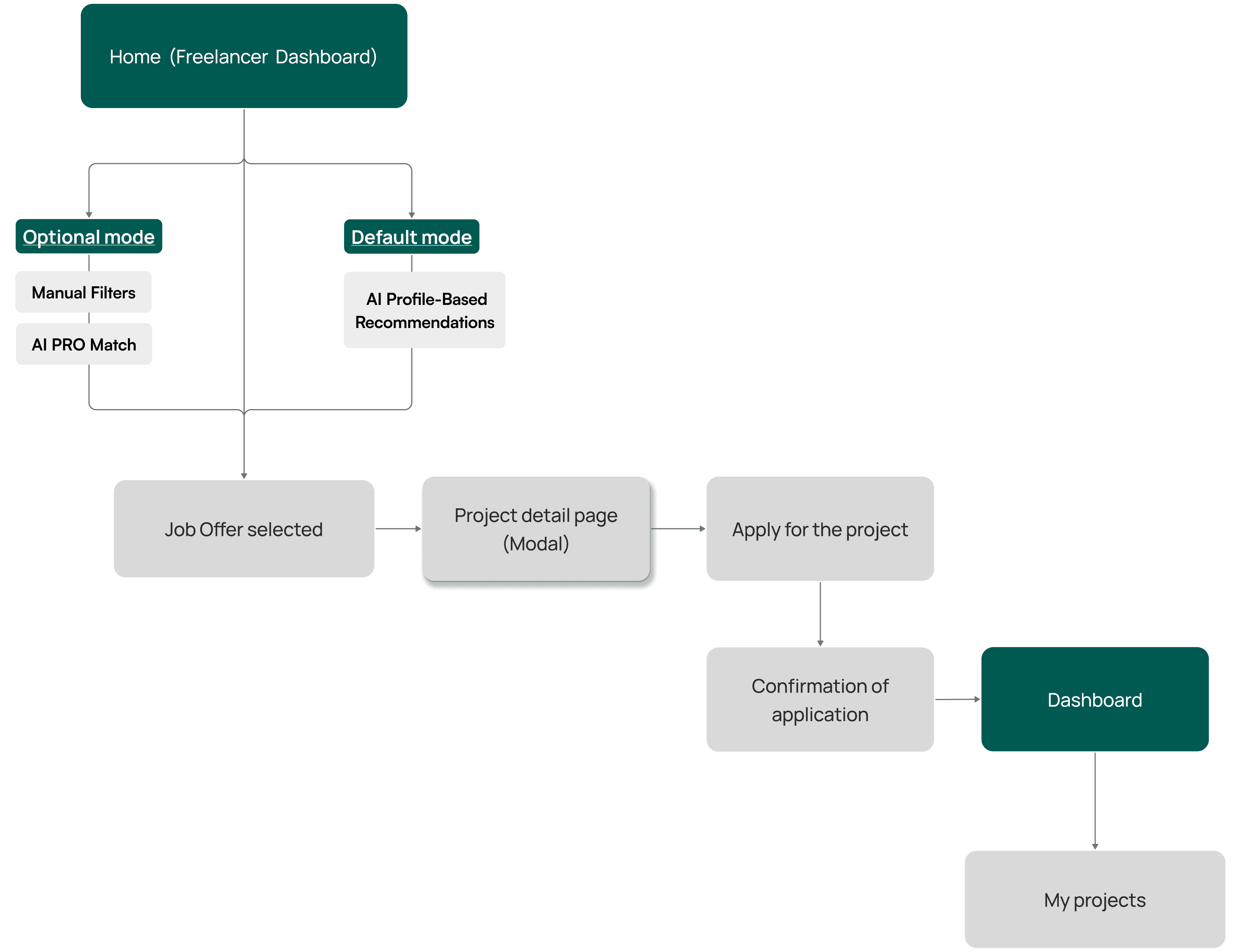CATEGORY:
UX/UI, Branding
SECTOR:
B2C | SaaS | Freelance Marketplace | AI Integration
ROLE:
UX/UI & Brand Designer (solo)
DURATION | YEAR:
2.5 weeks (Sprint format) | 2025
FreeFlow: AI Job matching Platform for freelancers (B2C SaaS)
About.
FreeFlow is an AI-powered job discovery platform that helps freelancers instantly understand which opportunities are truly relevant to their skills, goals, and work preferences.
The design addresses a common freelancer frustration: endless scrolling through irrelevant roles with no clarity on why a job is a good match.
The platform introduces three core capabilities:
AI relevance score that instantly surfaces the strongest matches
Customizable filters with full transparency and control
A streamlined end-to-end flow that cuts job search time from 15–20 minutes to 3–5 minutes
My role
I designed the full experience end-to-end, defining UX strategy, shaping the interaction logic, and building a clear, emotionally supportive UI that helps freelancers move from uncertainty to clarity and confidence.
User testing results showed
70% decrease in reported stress during job exploration (stress levels were measured through pre- and post-test self-reported evaluations on a 1–5 scale)
A clear preference for FreeFlow’s guided, transparent experience compared to existing platforms
Freelancers don’t just need jobs, they need clarity, relevance, and the feeling of being truly understood.
Research & insights.
It’s so hard to know which client to trust and even harder to find work that actually fits my skills. Everything just feels like noise.
This is what I heard repeatedly during early interviews.
To design a product that truly supports freelancers, I started with deep immersion, not assumptions. My goal was to understand how freelancers search, what overwhelms them, and what kind of support they're missing.
01 | Pain Points
Through early interviews and surveys, freelancers repeatedly described the same frustrations:
Endless irrelevant job results and low-quality recommendations
Difficulty trusting project details and payment reliability
Time wasted filtering chaotic listings
Uncertainty around legal/tax implications when working internationally
Lack of clear comparison tools to evaluate job opportunities
These recurring pain points shaped the core UX strategy and feature direction.
02 | Key Insights from Research
My mixed-method research (11 interviews + 34 survey responses) revealed two dominant patterns:
73.5% feel overwhelmed by irrelevant or generic job recommendations
87.7% struggle to quickly understand the credibility, legality, and fit of remote job opportunities
Together, these insights confirmed the need for:
Transparent, trustworthy job evaluation
A relevance-first approach powered by AI
Reducing search fatigue through guided, structured navigation
Additional Insights
Trust and clarity consistently emerged as top unmet needs for freelancers using remote job platforms.
Trust breaks down when platforms offer endless, impersonal lists with unclear client credibility
Users want clear reasoning behind job suggestions: not just titles and tags
Freelancers seek reassurance before applying: “Is this safe? Is this legitimate? Does it fit me?”
Desktop and mobile audits showed inconsistent logic across existing platforms, reinforcing the need for a clear, predictable navigation model
Competitive analysis revealed a strong need for a dual-platform structure: mobile for quick scanning and desktop for deeper evaluation (both built on the same interaction logic)
03 | From Insights to Structure
After identifying key patterns around trust, search fatigue, and decision friction, I translated these findings into a clear product structure using the following strategic UX tools:
• User Persona & Journey Mapping to uncover emotional triggers and map decision points across the job-search journey

• Affinity Mapping to group insights into themes that shaped early navigation and feature direction

• MoSCoW Prioritization to define which features were essential for the MVP and which could be added later
• SWOT Analysis to position the product against competitors and identify differentiation opportunities
• Card Sorting to validate how freelancers mentally organize tasks, filters, and job-evaluation criteria
Together, these tools shaped a clear, dual-mode job-recommendation structure — a core AI-powered experience supported by optional advanced controls (Manual Filters and AI PRO Match). This architecture was designed to reduce overwhelm, rebuild trust, and create a transparent, predictable path for freelancers.
04 | From Strategy to Core Flow
Turning insights into a focused, dual-mode user experience.
After clustering the research findings and defining MVP priorities, I designed the core user flow for FreeFlow — a streamlined job-matching path that reduces cognitive load and supports two complementary ways of exploring opportunities.
FreeFlow introduces a dual-mode structure:
Default Mode: AI Profile-Based Recommendations
A lightweight, instant suggestions feed generated from the freelancer’s profile and preferences. This mode eliminates irrelevant results and gives users a clear, credible starting point without requiring any manual inputOptional Mode: Manual Filters & AI PRO Match
An alternative exploration path. Freelancers can browse manually or use AI PRO Match, an advanced model that considers behavioral patterns (search history, saved roles, interactions) to generate highly personalized, percentage-based matches.
This flow reflects three key decisions:
Reducing noise → the default mode begins with AI Profile-Based Recommendations, while the optional mode supports deeper exploration for freelancers who prefer control or advanced personalization
Reducing cognitive load → filters and job details were restructured to surface only what freelancers actually use to evaluate credibility (role fit, legal safety, payment clarity)
Shortening the decision path → the job-application route was simplified to 3 predictable screens
While the platform supports manual browsing, FreeFlow’s two AI-powered path, the default recommendation engine and the advanced AI PRO Match, form the foundation of a calm, transparent experience that enables fast, confident decision-making.

Result.

01 | Solutions
Turning UX strategy into tangible product outcomes
Based on the defined core flow, I translated the product logic into concrete, user-facing solutions that simplify job discovery and build trust.
Solution 1 Unified Search Experience
Three complementary modes designed for different user behaviors:
AI Profile-Based Recommendations (default): delivers instant, relevant opportunities based on core profile data, ideal for fast browsing and low-effort job discovery
AI PRO Match (Behavior-Driven): a premium, adaptive matching engine that learns from user actions, searches, and preferences. Produces compatibility scores and highly precise recommendations
Manual Filters: a fully controlled search mode for freelancers who prefer explicit filtering and granular decision-making
This system ensures that every user from beginners to experienced freelancers can choose the level of automation and transparency they are comfortable with.
Solution 2 Transparent Recommendation Logic
To rebuild trust, each job card clearly explains why it appears:
“Why this job?” micro-explanations
Key matching criteria surfaced upfront
Consistent clarity around role fit, safety, and payment
This transparency removes guesswork, reduces skepticism, and supports informed decisions.
Solution 3 Focused, High-Clarity Job Cards
Job cards were restructured to reduce cognitive load and highlight only what freelancers actually use to evaluate credibility:
Role fit indicators
Payment clarity
Legal/safety information
Expected time commitment
Key requirements in a scannable layout
This design enables faster triage and reduces the typical “information overload” associated with job platforms.
Solution 4 Streamlined 3-Step Application Flow
Following the optimized core path, the job-application journey was simplified to three predictable steps:
View job details (Modal)
Apply
Receive confirmation → Dashboard
This reduces friction, prevents navigation loss, and guides freelancers through a calm, confident decision-making process.
Solution 5 A Consistent, Trust-Oriented Visual Language
The interface uses:
Minimal cognitive noise
Predictable structure
Soft hierarchy
Supportive micro-interactions
Together, these elements form a visual environment that feels calm, transparent, and trustworthy, aligning with the emotional needs identified during research.
02 | Visual System & Branding
The visual identity of FreeFlow was shaped by the emotional state of the user.
Freelancers facing chaotic platforms, unclear filters, and trust issues need a space that feels calm and supportive — not noisy or salesy. The color system is soft and neutral, creating a sense of clarity and psychological comfort.
Typography prioritizes readability, and all components follow a clear hierarchy with generous spacing. The brand tone is friendly, mature, and empathetic — designed to feel like a steady companion, not a loud marketplace.

Final Screens and Prototype
Based on user interviews and competitor research, it became clear that freelancers frequently switch between devices — browsing jobs on the go and managing applications in focused desktop sessions.
To support this behavior, I designed both a responsive web platform for full control and a mobile app for fast access, communication, and tracking.
The final prototype brings together everything defined through user research, prioritization, and interaction logic. It reflects a calm, intelligent interface that guides users through the job search process — with AI-driven suggestions, real-time filtering feedback, and lightweight interactions.
Key features visible here include:
– AI clever filtering - quick smart suggestion powered by AI
– AI Match PRO - advanced matching tailored to the user's full profile
– Manual Filtering, including Job relating filters section and Client relating filters section
The UI structure aims to feel intuitive and non-intrusive, respecting the user’s pace and preferred level of autonomy
Testing & Iteration
To validate the direction of the user flow, I conducted a moderated 1:1 usability test with a real freelance professional. I observed how they interacted with the prototype in real time, focusing on the job search flow.
Key insights from the session:
→ Job cards felt overloaded with too much information at first glance
I iterated by stripping the cards down to only the most essential data, moving details to the job description page.
→ Job search flow felt intuitive and self-guided
The user was able to complete the main path without help, confirming the strength of the chosen structure.
Changes made after testing:
Simplified job cards for better scanability
Emphasized core job-seeking flow as the platform’s central experience
Added clear CTA and reduced clutter in the AI suggestions screen
This session confirmed that focusing on one core flow — AI-powered job suggestions — was the right UX decision, both in terms of UX and user emotional experience.
Next Steps
Building on the initial user flow and core AI recommendations, the next phase of FreeFlow would focus on deeping trust and long-term value for cross-border freelancers.
Planned future enhancements include:
→ Localized onboarding guidance
Tailor the onboarding flow based on user's location and legal context, making setup feel more relevant and reassuring
→ Legal & Tax Resource Hub
Provide region-specific content and tools that help freelancers navigate complex compliance questions
→ Expert access
Offer on-demand consultations with verified professionals in cross-border legal and tax fields
→ Community and mentorship Layer
Create a support space for freelancers to share experience, ask questions, and grow through connection
Takeaways
Empathy guided every design decision — not just research. As someone who’s lived the experience of a relocating freelancer, I knew that emotional safety is just as important as clean UX. I didn’t just follow the data — I asked myself:
“What would make me feel calm, in control, and welcome here?”
That question shaped every decision — from flow to tone to layout spacing.
Testimonial.
I tested the platform and it felt smooth and intuitive. The interface guided me without ever forcing me — I could clearly see what was happening and why.
Fabian Homburg
UX/UI | Graphic Designer



